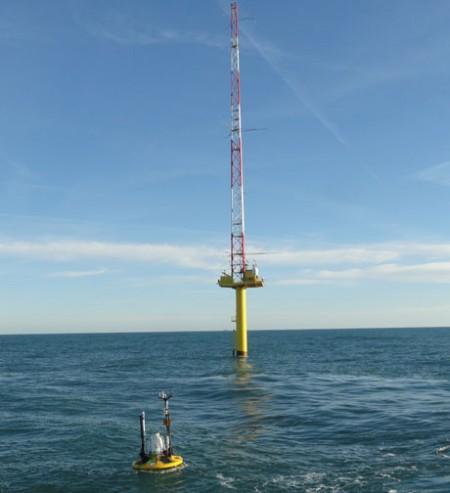 Metocean buoy in front of met-mast in the North Sea. (Credit: RWE)
Metocean buoy in front of met-mast in the North Sea. (Credit: RWE)
Wind, waves and currents have a profound impact on the construction, the operation and maintenance of offshore wind farms. Therefore, the offshore windfarm Eneco Luchterduinen and RWE Innogy are testing a new and innovative metocean buoy that has been installed this week in the Dutch North Sea.
The buoy has been deployed for a six month validation period nearby the already existing IJmuiden meteorological mast of RWE Innogy, some 75 km (46.6 miles) west off IJmuiden in the Tromp Binnen wind farm area. The floating platform with a diameter of 2.8 meter (9.19 ft) and a weight of around 1.7 tonnes is collecting data on wind, current, wave and ambient conditions. An independent analyst will evaluate the data, with the results expected to be available in summer 2014. The project is co-funded by FLOW (Far and Large Offshore Wind), a research and development program sponsored by the Dutch Ministry of Economic Affairs.
“Wind and wave data is of fundamental importance for the development, construction and operation of offshore wind farms. Affordable non-stationary equipment for accurate assessment of wind resources can improve the measuring methodology and ultimately reduce costs for offshore wind projects”, Ruben Dijkstra, Director Wind Offshore Eneco, said. “After the six month testing period, we are planning to deploy the metocean buoy at our Eneco Luchterduinen offshore wind farm for a duration test of more than one year during the construction phase.”
The aim of the test is to find a cost efficient offshore measurement solution as an alternative for expensive fixed met-masts. Therefore, the measurement data recorded by the metocean buoy will be validated against the data of the IJmuiden met-mast. The buoy is equipped with a LiDAR (Light Detection And Ranging) device, a laser-based technology which is able to perform remote measurements of wind speed and direction. The SEAWATCH Wind LiDAR Buoy costs 10 to 20 per cent as much as a conventional met-mast and makes a significant contribution to reducing offshore wind development costs.
“This is the third testing and validation campaign conducted at an RWE Innogy site, the first both were deployed at our Gwynt y Môr offshore wind farm construction site in the UK. We expect to be able to demonstrate that metocean buoys are a reliable, accurate and cost-effective alternative for recording metocean data in challenging offshore conditions over an extended period of time,” explained Niels Bijkersma, Project Manager at RWE Innogy, adding: “We are committed to furthering the development of metocean buoy technology and are happy to make the IJmuiden met-mast available for this purpose.”
Lasse Lønseth, Project Manager at Fugro OCEANOR, said: “It has been important for us to develop a multi-purpose buoy for wind profiling, wave measurements and current velocity profiling. Through a comprehensive research project various alternatives have been tested. In our opinion we have combined the best in this buoy.”
The offshore industry can benefit from different angles: The insights can improve the wind farm layouts through better knowledge about load and wake effects. Metocean buoys can be used to perform wind resource assessments, to measure metocean conditions, to conduct power performance tests of wind turbines and to facilitate energy yield optimization of operating offshore wind farms. The buoys can be easily relocated and potentially substitute multiple met-masts during their operating life.

